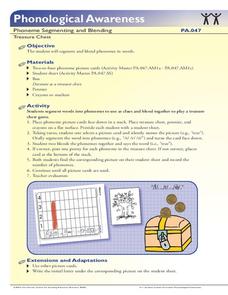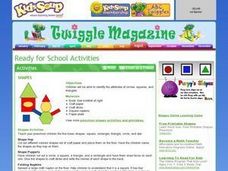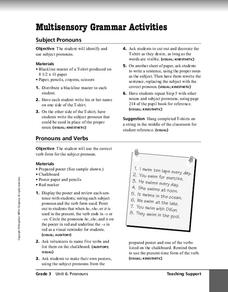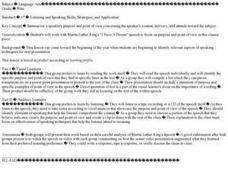Curated OER
Auditory Memory: Kindergarten
Test your kindergartener's auditory memory with this resource. They will listen to each sound imbedded in the presentation then determine which object presented made that sound, there are four different sounds to analyze.
Perkins School for the Blind
Familiar Sounds
To foster concept development and auditory discrimination skills, learners with visual impairments listen to identify a variety of common sounds. The teacher makes recordings of various sounds, including those found in the home, at the...
Florida Center for Reading Research
Sound Changes
Looking for an auditory approach to phoneme manipulation? You'll find everything you need here for an independent practice activity to get youngsters changing initial, medial, and final phonemes to create new words. They begin with a...
Curated OER
SIGHT READING RHYTHM PATTERNS
The perception of rhythms by reading and the ability to auditorily discriminate these rhythm patterns by listening to them performed by the teacher is practiced here. your students will work to create an eight-beat long rhythm pattern.
Curated OER
Identifying and Generating Rhyming Words, Body
Can you tell which words rhyme? Choose a body part as a starting word (i.e. head) and begin saying words to see if learners can identify those that rhyme. Does red rhyme with head? Continue giving examples, some...
Curated OER
Learning About Sounds
Students determine the sources of sound. In this auditory discrimination lesson, students listen to animal noises and various other noises. As students listen, they identify the sounds that they hear.
Curated OER
Rhythm and Art: Gesture Drawing
Students explore connections between non-verbal language and art. In this visual and auditory art lesson, students investigate the science of sound and principles of drawing. They then use various genres of music to directly apply that...
Florida Center for Reading Research
Treasure Chest
Segmenting and blending phonemes helps budding readers understand words. Use this strategy in an engaging game where partners test each other's auditory processing using familiar words. Using picture cards and a chart (included),...
Curated OER
Media Literacy Analyzed
Fourth and fifth graders define the term media literacy, then come up with examples that they share with the class. The types of media studied are auditory, visual, and written. Learners get together in pairs and perform a media...
Curated OER
Nature Poems
Students explore the visual, auditory, and verbal worlds offered by iLife applications to create a project that engages all learners and learning styles. They create a class book and CD of nature poems and artwork.
Perkins School for the Blind
The Mystery Box - Making Observations and Collecting Data
Making observations and collecting qualitative and quantitative data is a vital skill all scientists need to practice. Help your scientists with partial and no sight learn how to use their other senses to make observations for...
Curated OER
Extending our Knowledge of Place Value
Students demonstrate their knowledge of place value through auditory, visual, and kinesthetic channels. In this place value lesson, kinesthetic learners work with a partner using both sets of hands to represent 2 digit numbers. Visual...
Curated OER
Learning About Sounds
Learners practice identifying different sounds. In this auditory skills lesson plan, students listen to items that make different sounds. Learners discuss the sounds of different items and try to identify the sounds they hear.
Curated OER
Shapes Activities and Lessons
A fabulous lesson on identifying circles, triangles, squares, and rectangles awaits your students. They use large motor skills hopping from shape to shape, use visual and kinesthetic skills passing a ball of yarn between three people to...
Curated OER
World Religion Day: Reading Activities
If your class is observing World Religion Day in January, use this resource to provide a research and response opportunity. A short informational reading (available as an MP3 download for auditory learners and listening exercises) is the...
Illustrative Mathematics
Counting by Tens
With this daily counting activity, your kindergartners will master counting in sequence automatically from 0 to 100, and will count in multiples of ten to 100. With the whole class, count to 100. With each number, learners will whisper...
Perkins School for the Blind
Conductors of Heat - Hot Spoons
Why is the end of a spoon hot when it's not all the way in the hot water? A great question deserves a great answer, and learners with visual impairments will use their auditory and tactile senses to get that answer. A talking...
Howard Hughes Medical Institute
How Animals Use Sound to Communicate
Communication involves the visual, auditory, olfactory, and tactile senses. Scholars observe groups of animals communicating through multiple senses. They note and learn why different species use different senses depending on their...
New York State Education Department
Comprehensive English Examination: January 2015
Looking for practice for state standardized testing? Scholars work through a variety of passages and multiple question types in this exam. Questions range from comprehension of auditory passages, reading passages, and poems, as well as...
Curated OER
Pac Man Subtraction
Third and fourth graders engage in a game using visual symbols, auditory responses and tactile stimuli to further their understanding of subtraction. A worksheet imbedded in this plan explains how to teach the game.
Houghton Mifflin Harcourt
Multisensory Grammar Activities
Meet your scholar's individual needs with four activities designed to address auditory, visual, and kinesthetic learning styles to reinforce the concept of subject and object pronouns.
Curated OER
Martin Luther King's "I Have a Dream"
Dr. Martin Luther King's "I Have a Dream" speech provides the text for a study of how to analyze a speaker’s content, delivery and attitude. Visual learners identify specific lines that reveal King’s purpose and point of view while...
Curated OER
"I Banish You": Using Visual and Auditory Imagery to Connect with Speech
Learners analyze a monologue by Coriolanus in Shakespeare's play of the same name. In this literature lesson plan, students discuss and define betrayal and the events surrounding Coriolanus' banishment from Rome.
August House
The Clever Monkey Rides Again
Use a West African folktale to practice several different skills in your first grade classroom. Learners read The Clever Monkey Rides Again and focus on rhyming words, reading comprehension, measurement, art, movement, and word...
Other popular searches
- Auditory Discrimination
- Auditory Skills
- Auditory Processing
- Auditory Enrichment
- Auditory Discrimination R
- Auditory Learner
- Auditory Discrimination D
- Auditory Discrimination K
- Auditory Discrimination Perk
- Auditory Comprehension
- Auditory Cues
- Auditory Clues

























